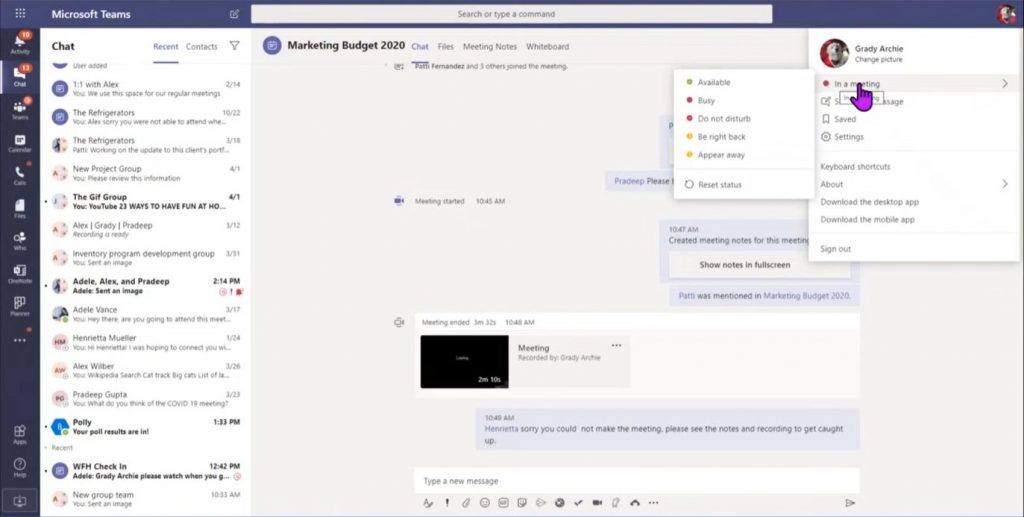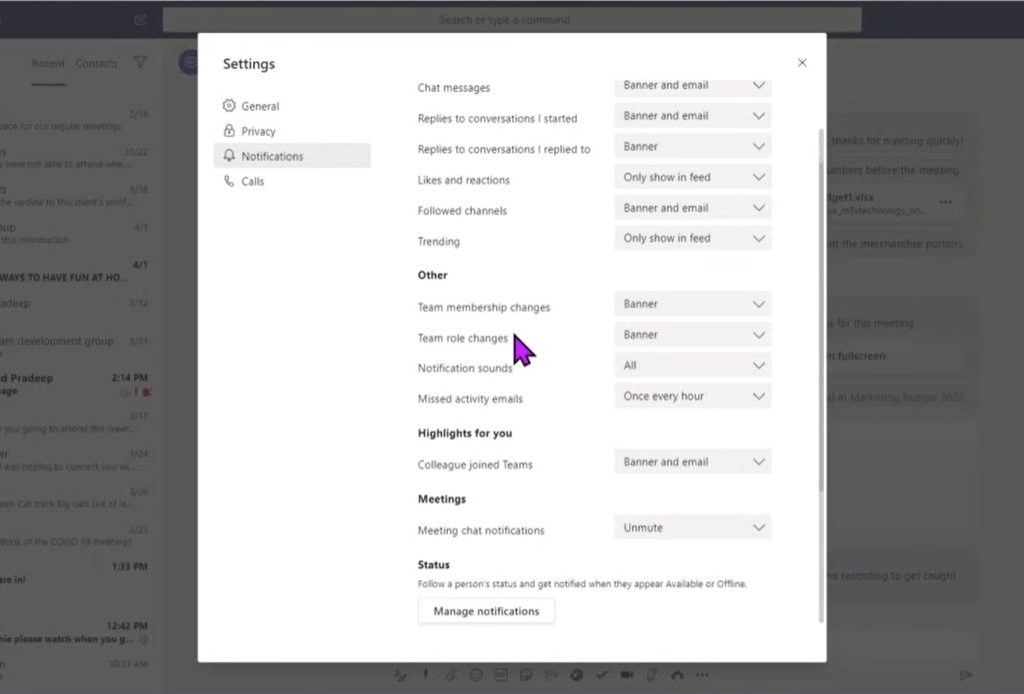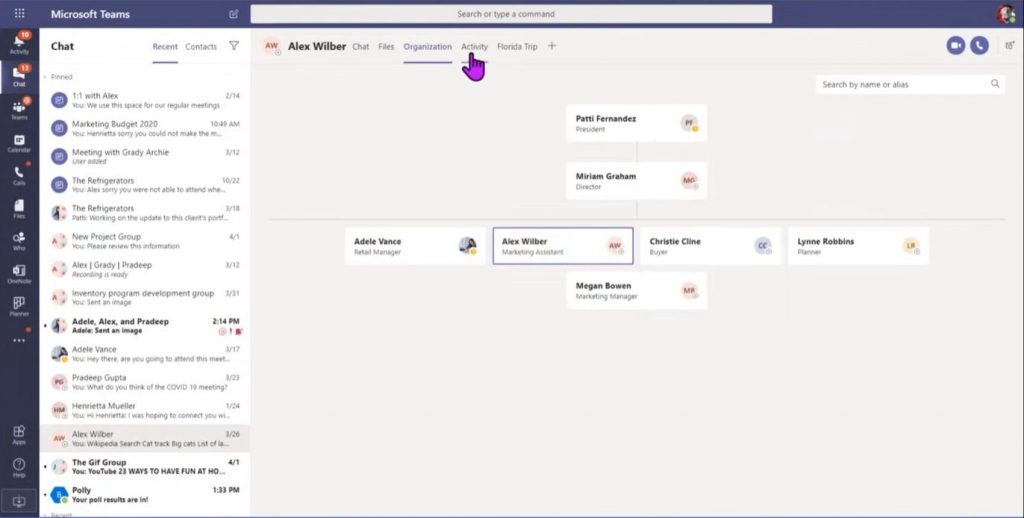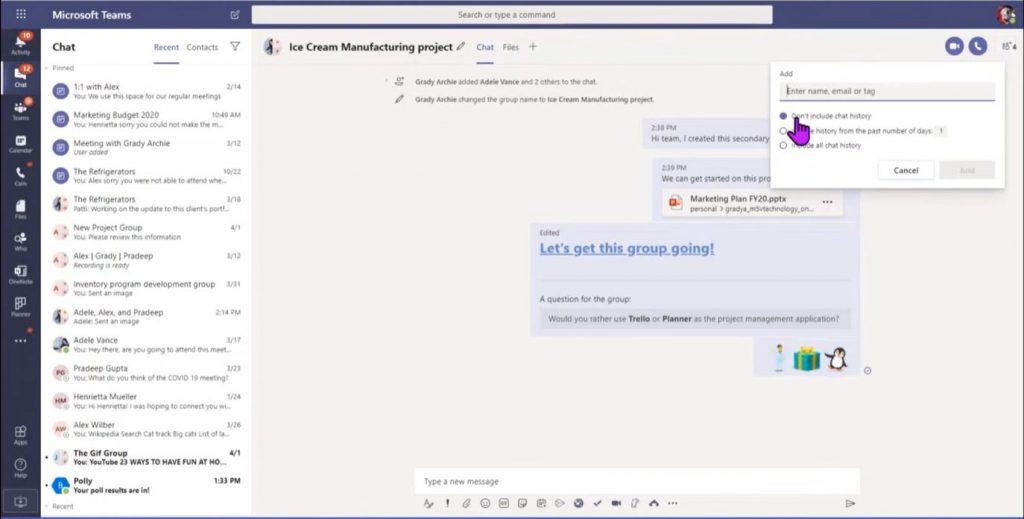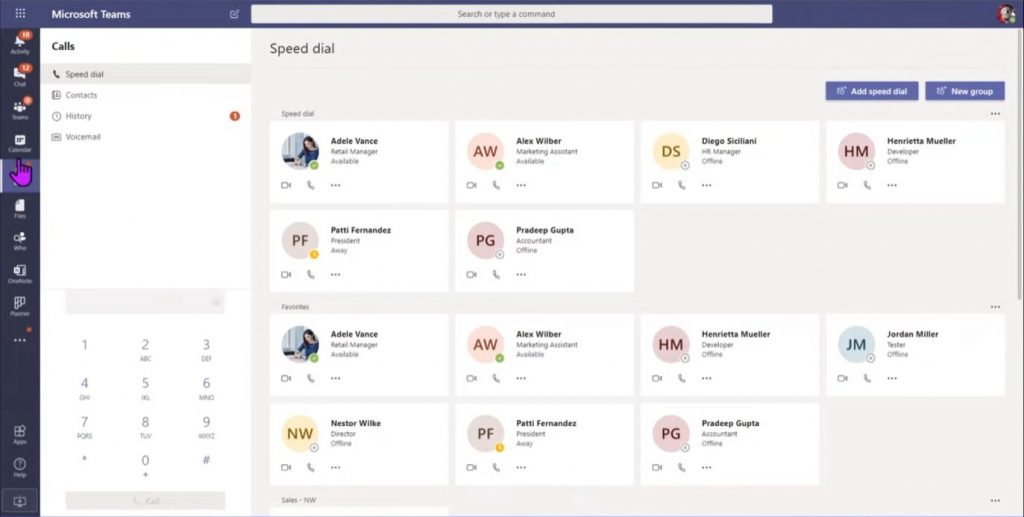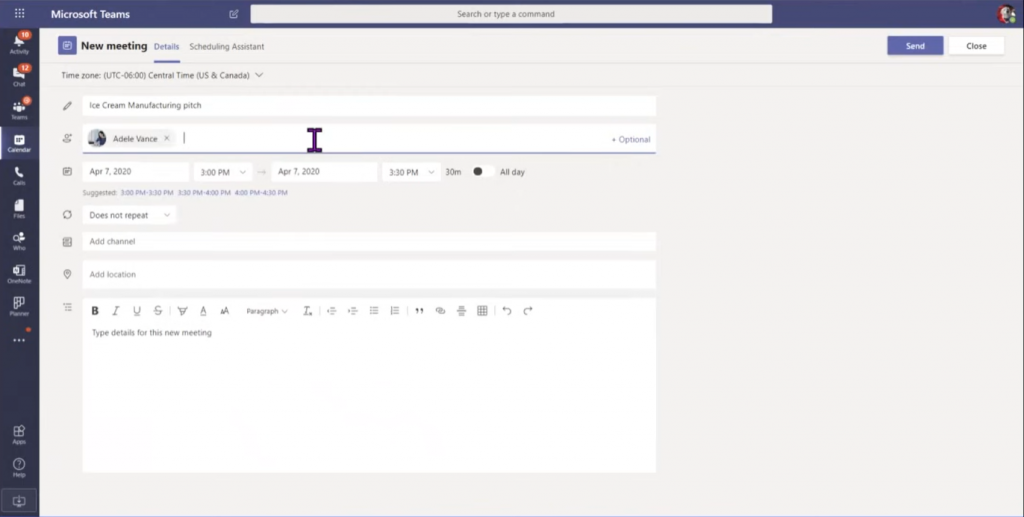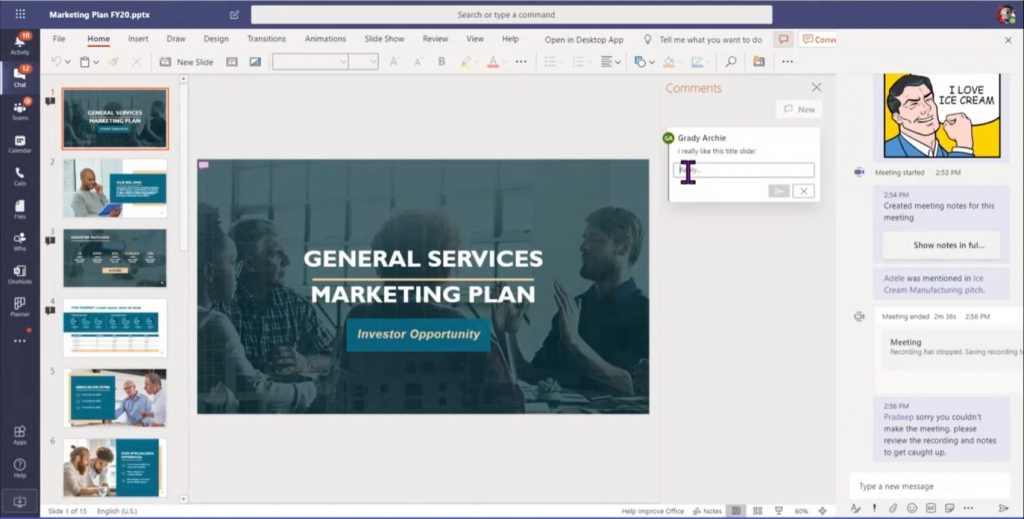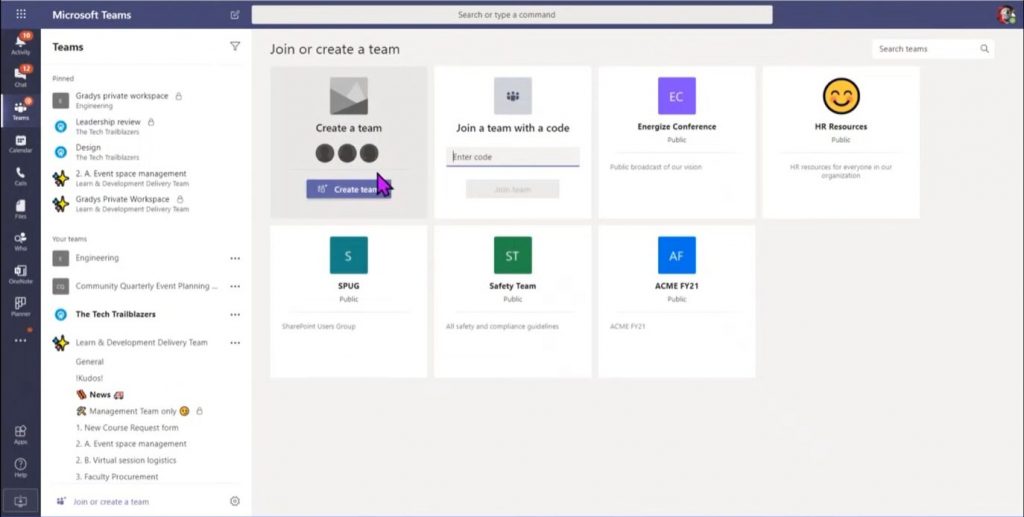Creating meaningful connections, organising meetings and collaborating on projects are some of the biggest challenges we face when we work with others, whether virtually or not. We have different jobs and varying responsibilities, which lead to us working in multiple spaces, windows and platforms that don’t talk to each other. These eventually cause inefficiency and miscommunication amongst the team.
With Microsoft Teams, you can create a comprehensive space for your team to work together. It’s a one-stop-shop that allows you to effectively store and access documents, manage projects, people and processes, and seamlessly integrate Microsoft and non-Microsoft applications.
Let’s start with setting up your Teams profile. When you click the profile icon, you can right away either change your profile picture or your status, which is automatically updated based on your Outlook and Teams calendar. Manually setting up your status is also possible, and every time someone hovers on your name or starts chatting with you, your status will pop out to let them know whether you are available or not. Take a look at a snippet here: 5:34-7:40.
In Settings, you can choose themes and languages and assign delegates – these are the people who can do various tasks such as scheduling meetings and returning chats on your behalf. Settings are where you can also grant priority access to contacts who you allow to reach you still even when you’re in a “Do Not Disturb” status. You can also set up which activities will notify you in the notifications part of the settings, depending on your personal preferences. You also get to specify what happens when someone calls you via Teams – whether all your devices logged in to Teams will ring simultaneously or whether it gets forwarded to your phone or the voicemail when no one picks up at your desktop. Moving on to the left pane, which you can consider your To-Do area, this is where you can pin any activity, so they appear on top of everything else you’re working on. If you like, you can also manually change the order. Here’s a quick preview of how it’s done: 7:41-10:35.
Creating Meaningful Connections
Connecting with people is all about communication, and Microsoft Teams gives you everything you need for one-on-one and group conversations. Persistent chat allows you to find past discussions and lets you resume where you left off. You also get to express yourself better using rich text formatting, graphics, giphys, emojis and stickers. The @mentioning feature is a great way to bring something to someone’s or a group’s attention. Aside from sending messages, you can also attach files directly for easier collaboration.
To start chatting, you need to click the icon with the pencil. As you type, you’d notice that it brings up recent conversations you’ve had or people you’ve talked with. When chatting with individuals, you can click on Organisation to see the bird’s eye view of where that particular person is in the Organisation. You can also add more tabs for tools and applications relevant to you and the individual you’re chatting with. You also have the phone and video icons if you want to progress the conversations to a phone call or video chat. Check out a quick video tutorial here: 14:08-15:59.
All conversations are private, so Teams creates a new staging area when you add other people to a conversation. To help you remember what your group is all about, you can rename it to reflect its purpose. At the bottom, you will see the chatbox, and right below it, you can access the rich-text formatting tool when you click ‘A’. The exclamation point icon will mark something as important and notify all the recipients every 2 minutes for 20 minutes. Below the chatbox, you will also find the emojis, giphys, stickers, and the three ellipses to install applications, such as Survey Monkey, Zoom, and more. Another cool thing about Teams is that whenever you add someone to a chat, you can choose to include the entire chat history, a certain amount of it, like 2, 3, 14 days’ worth of information, or none of it so that you can protect the privacy of your group. Click this link to see how it’s done: 16:04-25:08.
Back at the left rail menu, once you click the call icon, you’ll be able to add new contacts or add existing ones to your speed dial group. This is where you can also check your call history, missed calls and voicemail. If you have a calling plan with Microsoft, you’ll also get a dial pad which makes calling easier. Take a look at a snippet here: 25:09-26:34.
Organising Meetings
Meetings can be scheduled via Outlook or Teams and set as a one-time thing or a recurring event. What’s excellent about Teams is that you can invite both internal and external folks to your meetings. External participants can join directly through the link sent to them when they receive the invitation using the web version of Teams, and they won’t even have to download Teams or have an existing license. Here’s a quick preview of how: 26:35-28:11.
Scheduling a meeting can be done in different ways. You can do it by accessing the calendar from the left rail menu or via the calendar icon below the chatbox. Once the meeting form is up, you can add a meeting name, invite people, edit the time and date, choose a repeating option, add a channel, and add a location if you’re used to meeting in a conference room. There’s also a scheduling assistant that you can use to make sure you’re plotting the meeting at a time everyone in your team is available. Once the meeting invite is sent it will appear in every participant’s calendar. You can right-click on it and start chatting, sharing content, and sending giphys or stickers to get the conversation going even before the scheduled meeting. Check out a video tutorial here: 28:13-33:50.
Aside from the usual things you can do when in a meeting, such as recording, live chatting, and sharing content with Teams, you can also take meeting minutes and use the rich-text formatting to make it more organised and creative. These meeting minutes are beneficial when someone in the team fails to join the meeting since they can go through the minutes to get caught up. Going back to sharing content, anybody can access shared files before, during and after the meeting. Participants can also co-author or leave comments, so the person responsible for bringing all those ideas together will be able to incorporate everyone’s remarks and information. These files can be accessed and updated using the desktop or browser version, and any changes made will still be saved to the original document. People may think that having all these recording meetings and uploaded files and notes is too much for the system to handle, but these are all hosted on the cloud in Microsoft’s Stream. Click this link to see how it’s done: 33:59-39:50.
Collaborating on Projects
Teams and Channels are two unique ways Microsoft helps you run projects, organise processes and manage people in a nice, robust and seamless manner. You can think of Teams as the house where everyone that’s part of the group gathers, while Channels are the different rooms of the house where people in charge of different things work together.
Depending on the need and your preferences, you can create Teams and Channels that are department-based or based on specific processes or projects. You can even create a Kudos channel solely for celebrating any milestone or achievement reached by different teams or individuals. Both Teams and Channels can be set as private or public and can have owners, members, moderators and guests with varying permission levels. When joining a public Team, all you have to do is click Join, and you’re automatically enrolled in that group. If it’s private, you’ll have to find the owner to ask for the code and input it before you can join. Check out this link to see how it looks like: 39:59-45:47.
Access and Compatibility
Microsoft Team is accessible on multiple devices such as PC, Mac, iPhones and Android. And whether you use one device or multiple ones, switching between them won’t be a problem since the look, feel, and functions are the same. If you need more help in getting started with Microsoft Teams, send us a message or give us a call so we can help you set up a one-stop shop for your Organisation.

